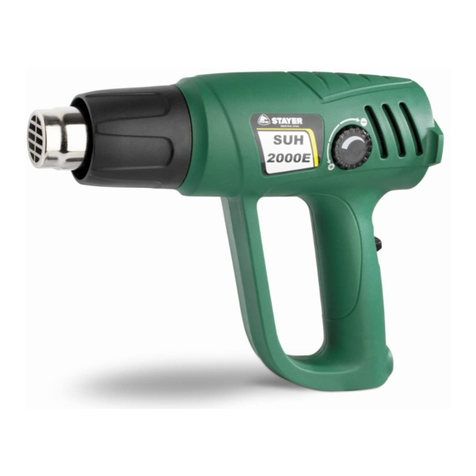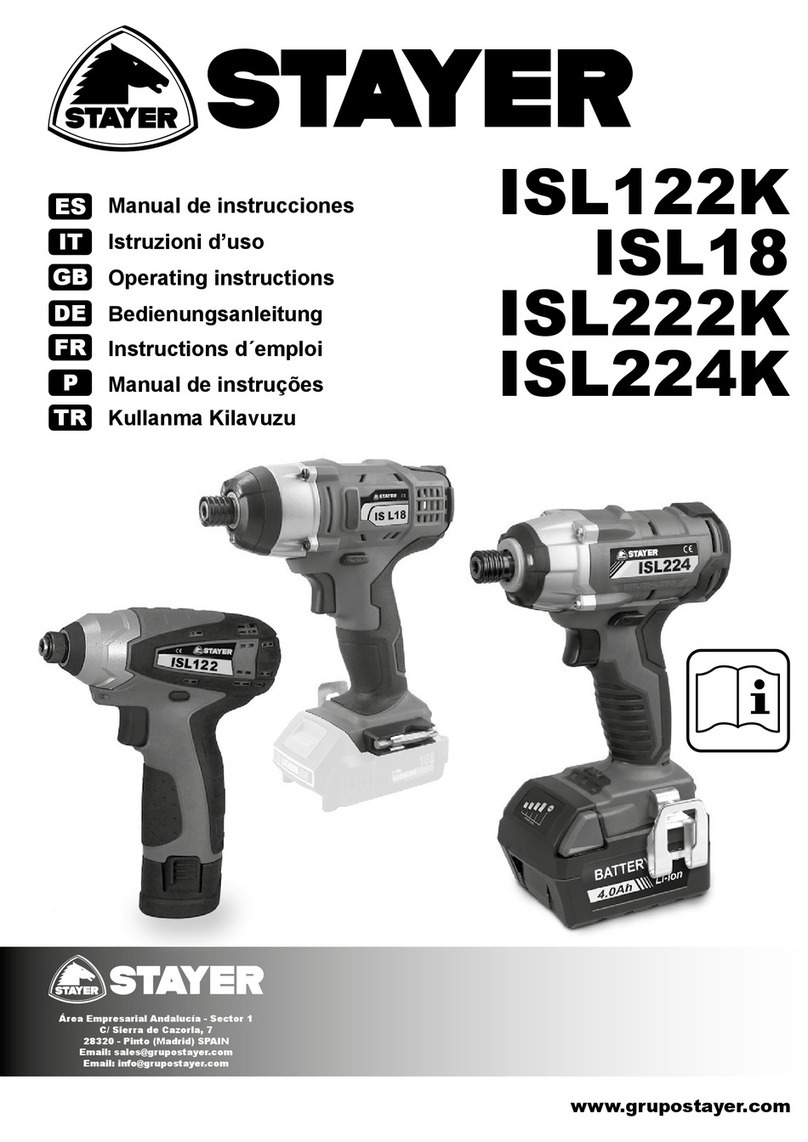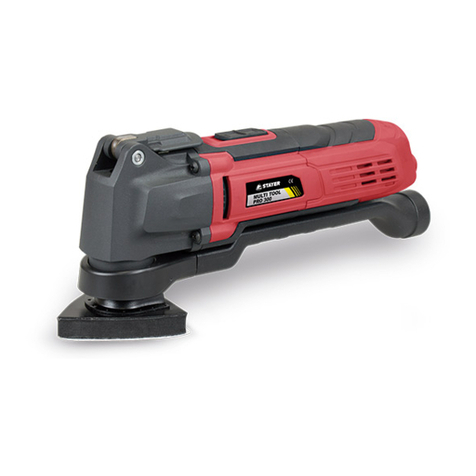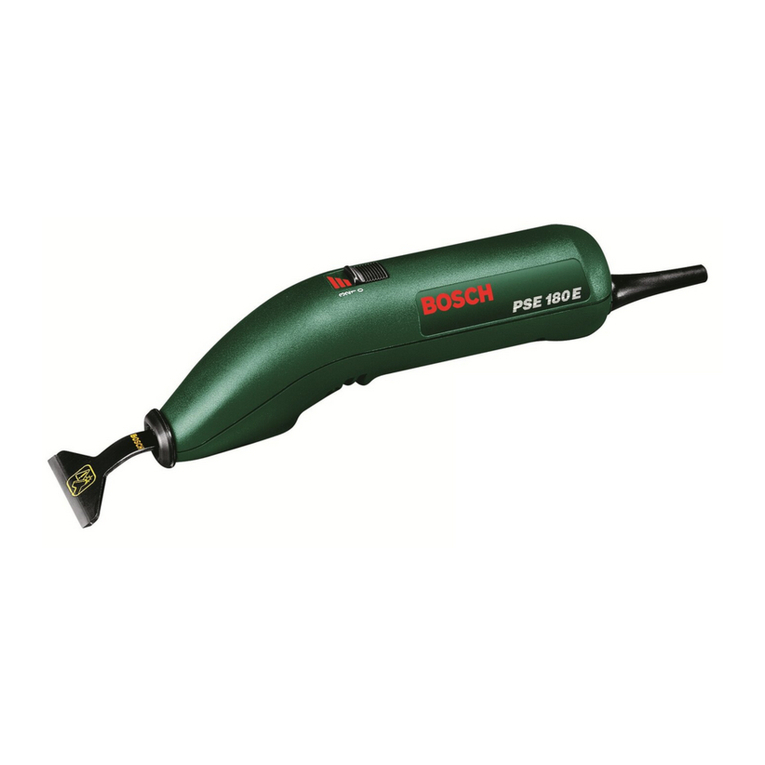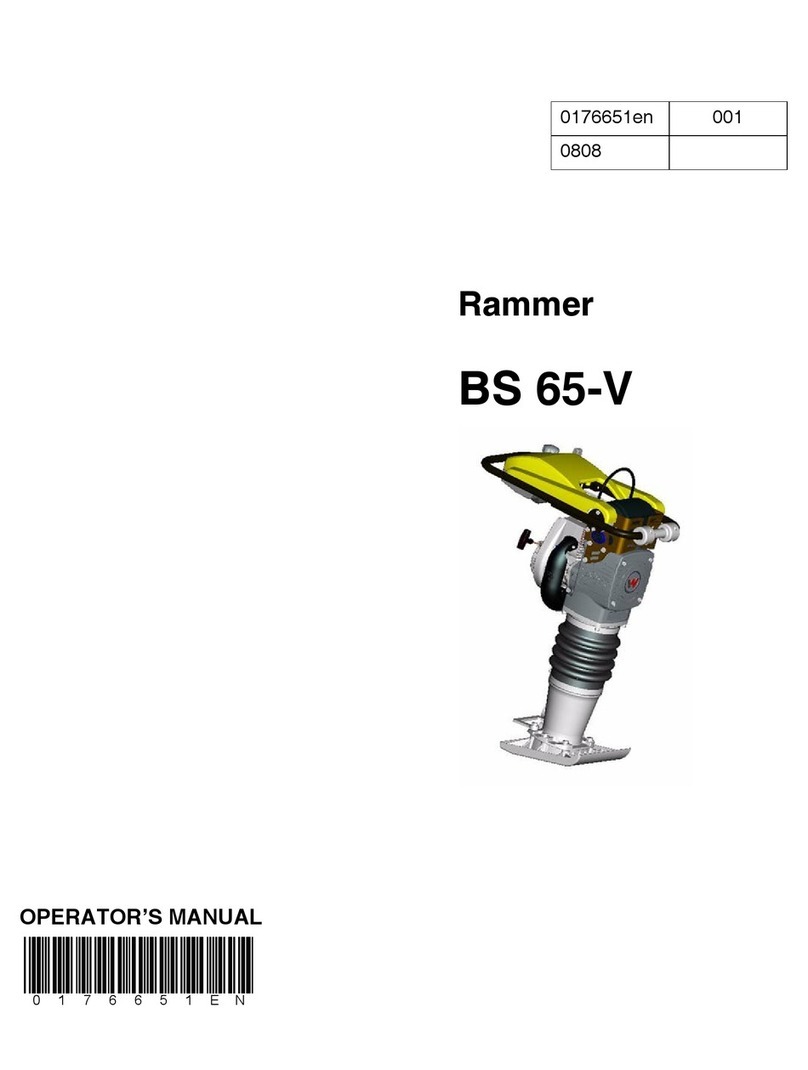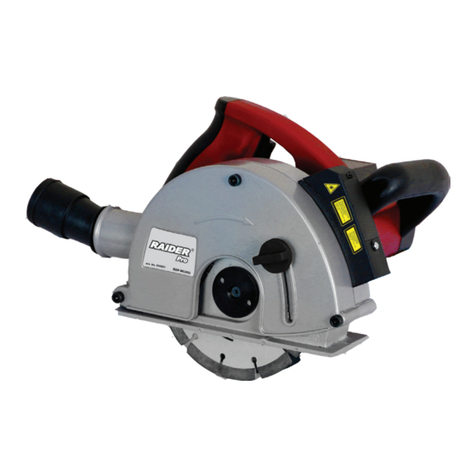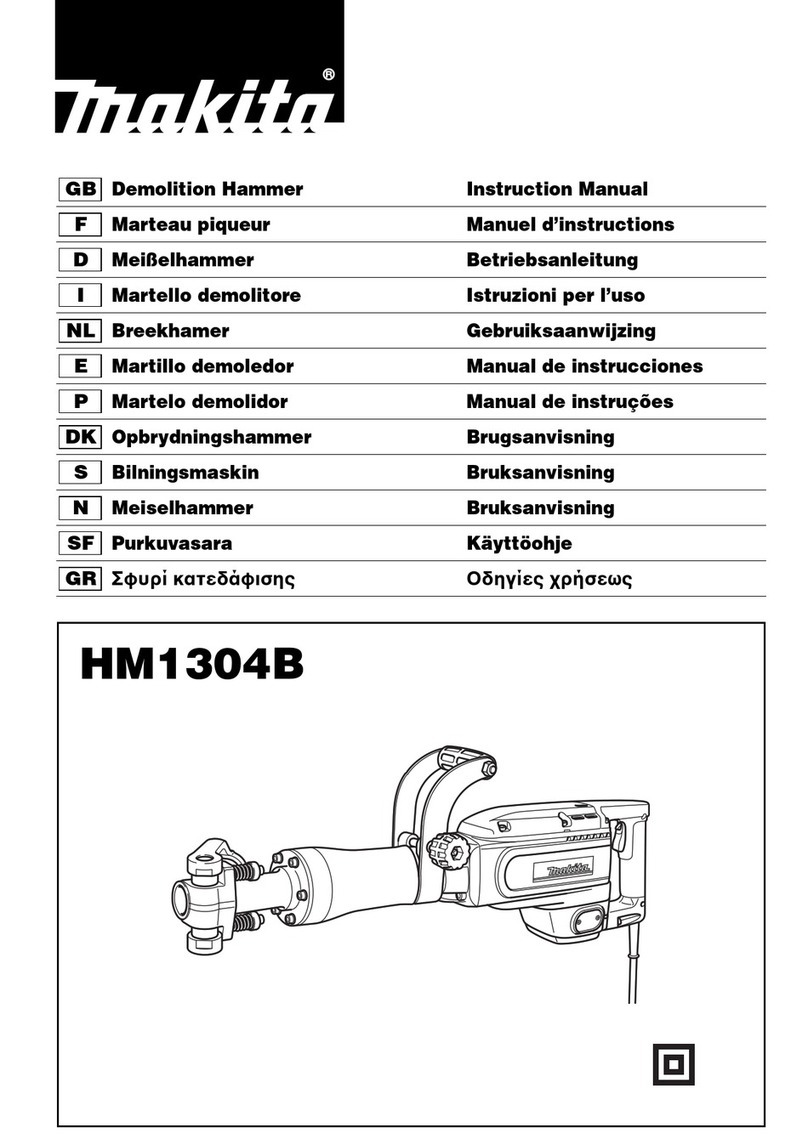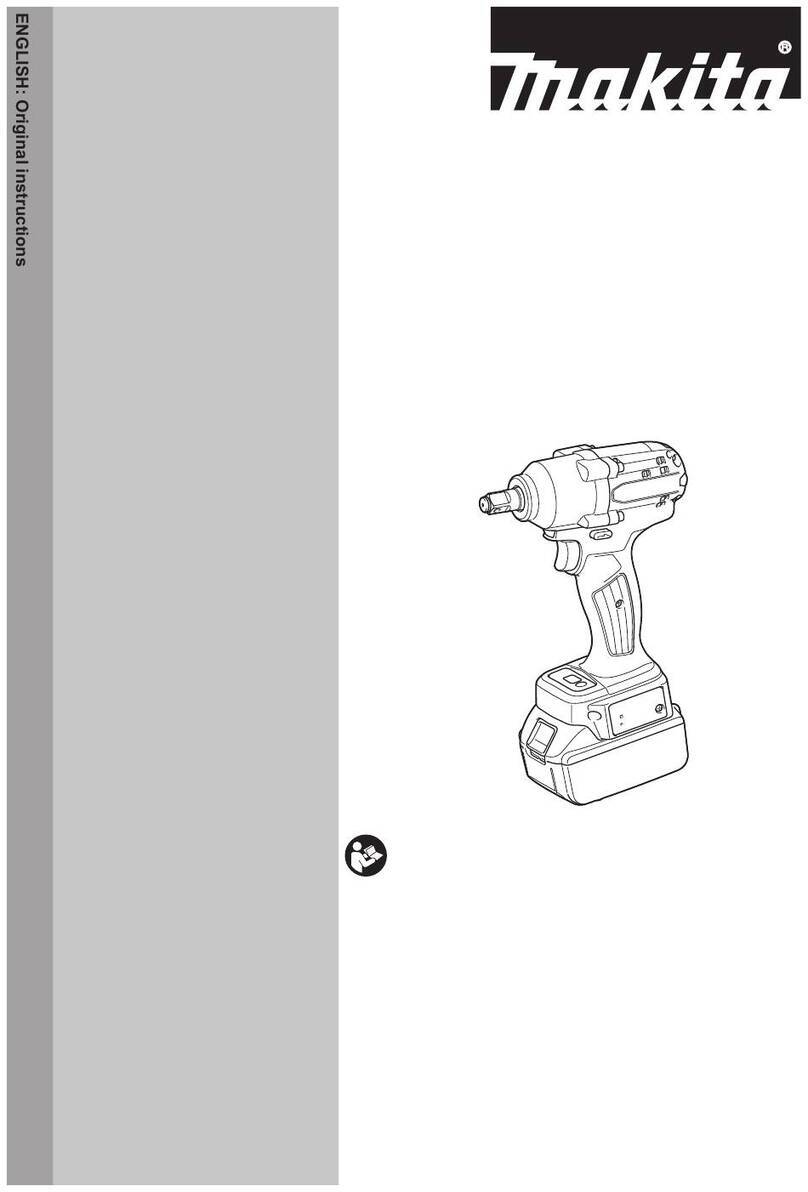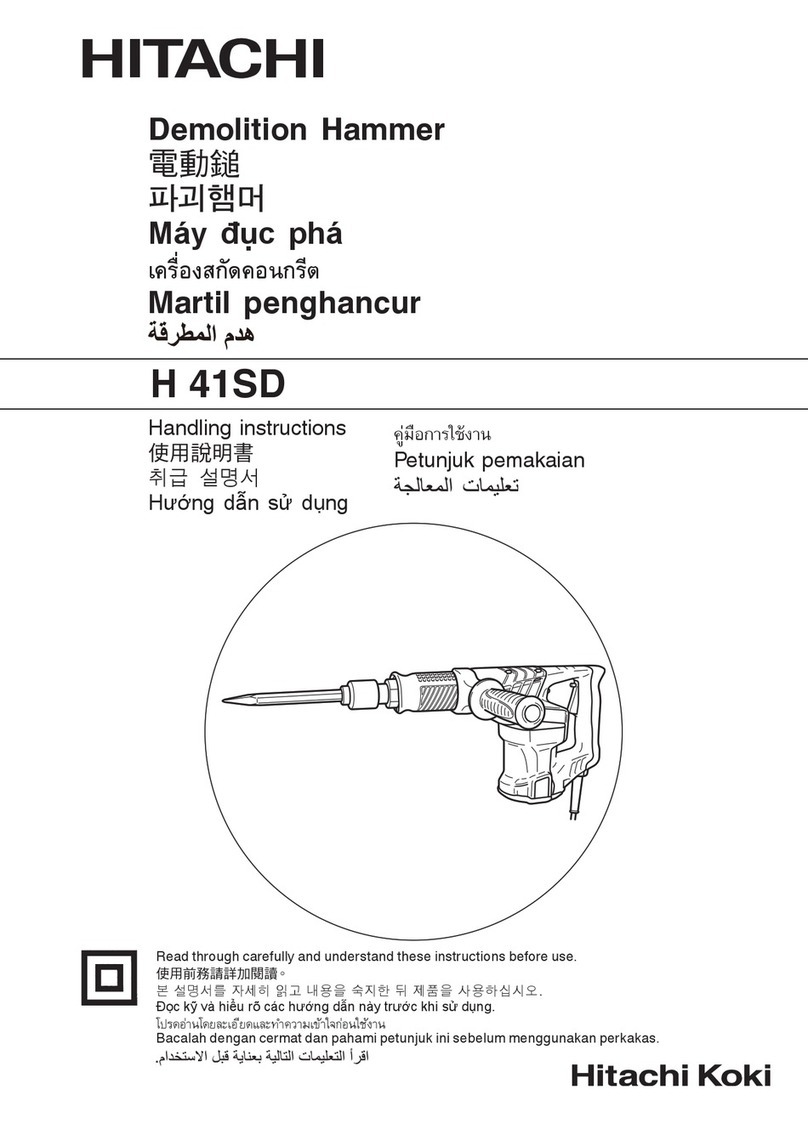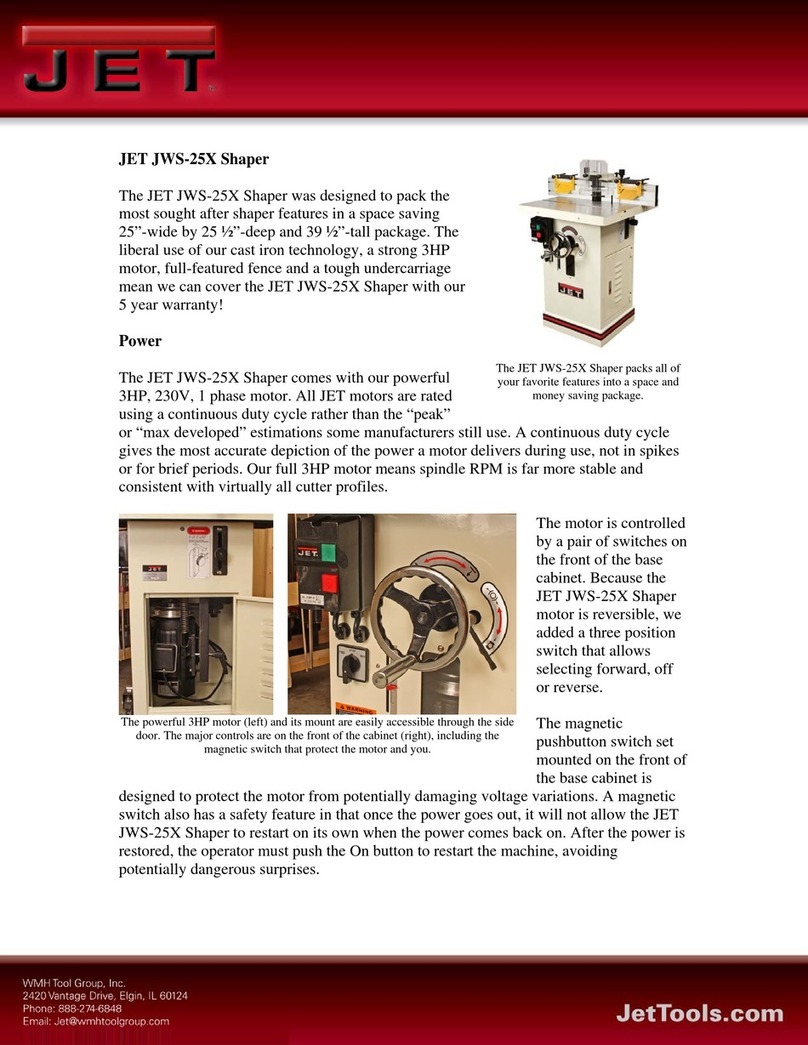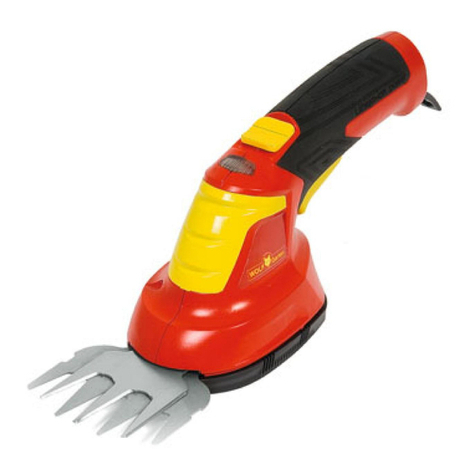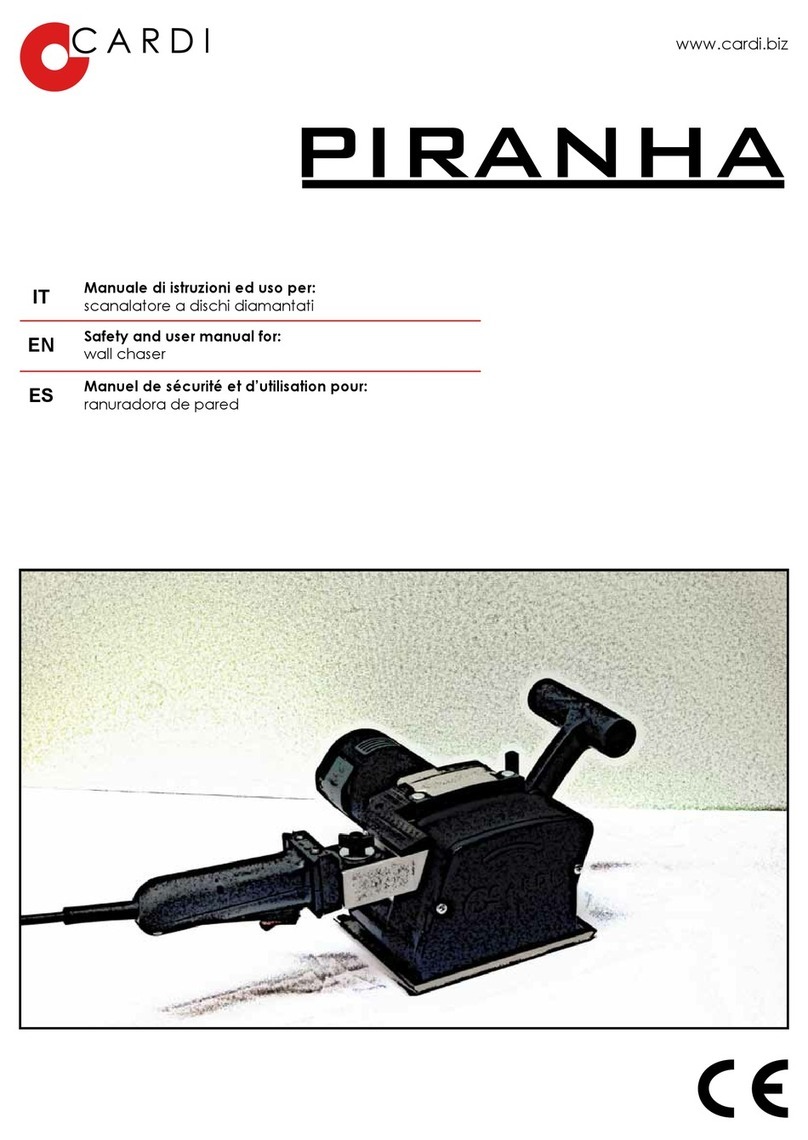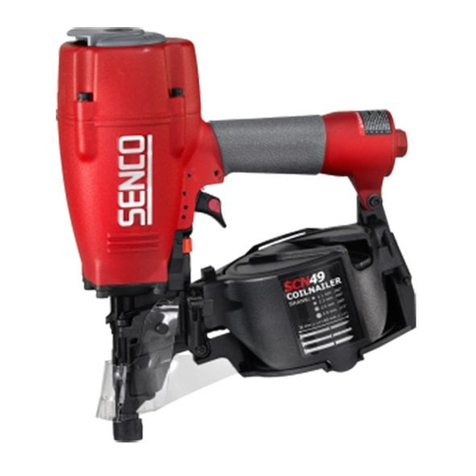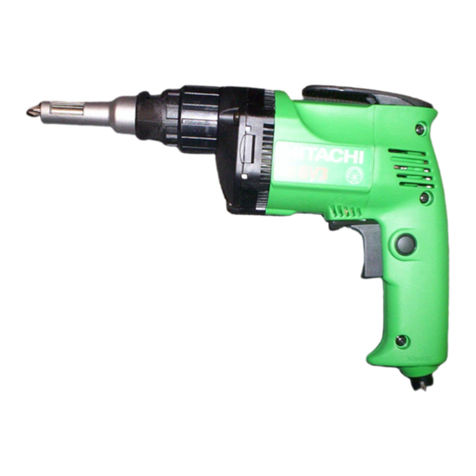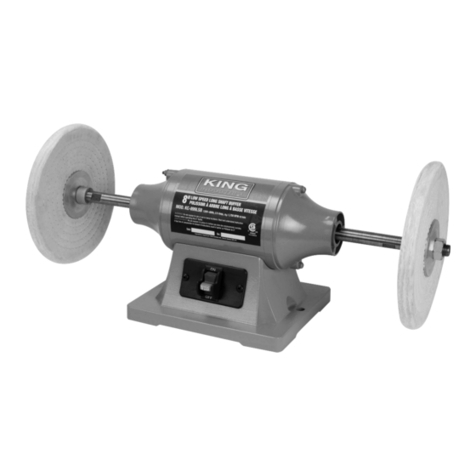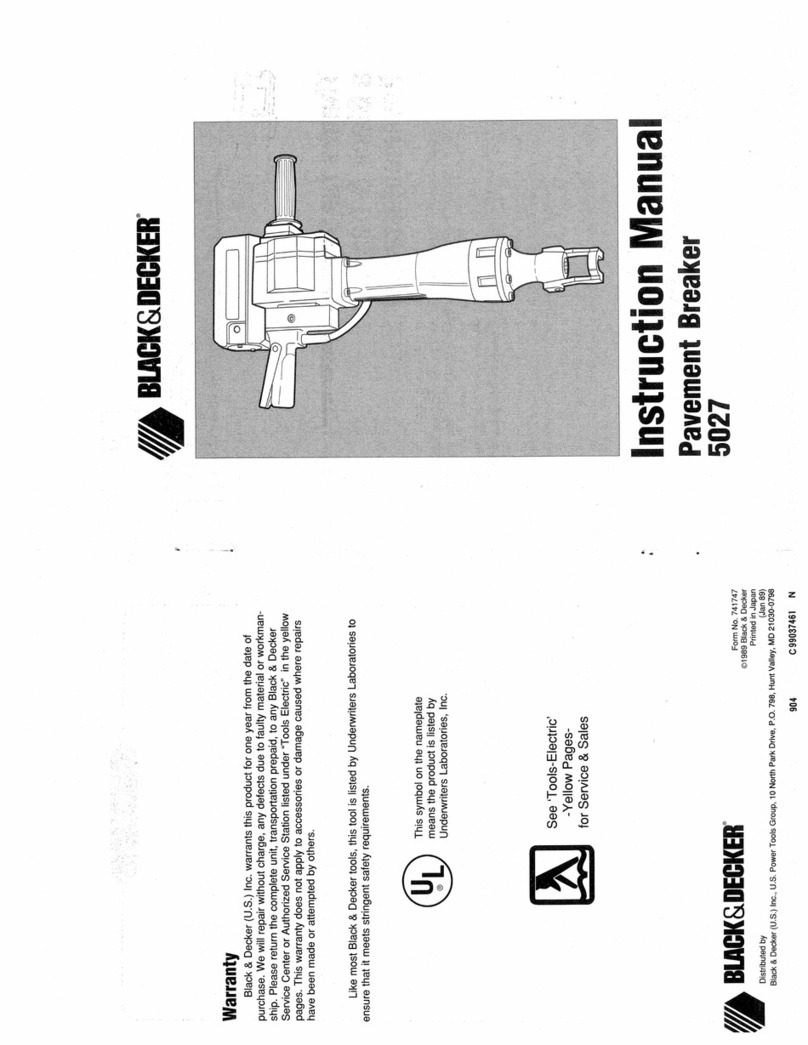stayer IW 550 User manual

es
gb
Manual de instrucciones
IW 550
Área Empresarial Andalucía - Sector I
Calle Sierra de Cazorla nº7
C.P: 28320 Pinto (Madrid) SPAIN
info@grupostayer.com www.grupostayer.com
Operating instructions

4
3
3
2
1

IW550
W950
min-1 2300
Nm 550
M6-18
1/2"
Kg 3.4
II
3
W
rpm

- 4 -
es
Este manual es acorde con la fecha de fabricación de
su máquina, información que encontrará en la tabla de
datos técnicos de la maquina adquirida, buscar actua-
lizaciones de manuales de nuestras maquinas en la
página web: www.grupostayer.com
Esta máquina ha sido diseñada para amolar,
lijar, tronzar y trabajar con cepillo, sin la apor-
tación de agua. En combinación con los úti-
les de lijar autorizados, es posible emplear
también la herramienta eléctrica para lijar.
1_INSTRUCCIONES ESPECIFICAS DE
SEGURIDAD
Advertencias de peligro generales para herramien-
tas eléctricas
Lea íntegramente estas advertencias de peligro
e instrucciones. En caso de no atenerse a las adve
tencias de peligro e instrucciones siguientes, ello pue-
de ocasionar una descarga eléctrica, un incendio y/o
lesión grave.
Guardar todas las advertencias de peligro e ins-
trucciones para futuras consultas.
El término herramienta eléctrica empleado en las si-
guientes advertencias de peligro se reere a herra-
mientas eléctricas de conexión a la red (con cable de
red) y a herramientas eléctricas accionadas por acu-
mulador (o sea, sin cable de red).
Seguridad del puesto de trabajo
Mantenga limpio y bien iluminado su puesto de
trabajo.
El desorden o una iluminación deciente en las áreas
de trabajo pueden provocar accidentes.
No utilice la herramienta eléctrica en un entorno
con peligro de explosión, en el que se encuentren
combustibles líquidos, gases o material en polvo.
Las herramientas eléctricas producen chispas que
pueden llegar a inamar los materiales en polvo o
vapores.
Mantenga alejados a los niños y otras personas
de su puesto de trabajo al emplear la herramienta
eléctrica.
Una distracción le puede hacer perder el control sobre
la herramienta eléctrica.
Seguridad eléctrica
El enchufe de la herramienta eléctrica debe co-
rresponder a la toma de corriente utilizada. No es
admisible modicar el enchufe en forma alguna.
No emplear adaptadores en herramientas eléctri-
cas dotadas con una toma de tierra. Los enchufes
sin modicar adecuados a las respectivas tomas de
corriente reducen el riesgo de una descarga eléctrica.
Evite que su cuerpo toque partes conectadas a
tierra como tuberías, radiadores, cocinas y refr
geradores. El riesgo a quedar expuesto a una s cudi-
da eléctrica es mayor si su cuerpo tiene contacto con
tierra.
No exponga la herramienta eléctrica a la lluvia y
evite que penetren líquidos en su interior. Existe
el peligro de recibir una descarga eléctrica si pen tran
ciertos líquidos en la herramienta eléctrica.
No utilice el cable de red para transportar o co gar
la herramienta eléctrica, ni tire de él para sacar el
enchufe de la toma de corriente. Mantenga el cable
de red alejado del calor, aceite, esquinas cortantes
o piezas móviles. Los cables de red d ñados o enre-
dados pueden provocar una desca ga eléctrica.
Al trabajar con la herramienta eléctrica a la intem-
perie utilice solamente cables de prolongación
apropiados para su uso en exteriores. La utiliz ción
de un cable de prolongación adecuado para su uso en
exteriores reduce el riesgo de una de carga eléctrica.
Si fuese imprescindible utilizar la herramienta
eléctrica en un entorno húmedo, es necesario c
nectarla a través de un fusible diferencial. La apl
cación de un fusible diferencial reduce el riesgo a ex-
ponerse a una descarga eléctrica.
Seguridad de personas
Esté atento a lo que hace y emplee la herramie ta
eléctrica con prudencia. No utilice la herramien-
ta eléctrica si estuviese cansado, ni tampoco de
pués de haber consumido alcohol, drogas o med
camentos. El no estar atento durante el uso de la he-
rramienta eléctrica puede provocarle serias lesiones.
Utilice un equipo de protección personal y en todo
caso unas gafas de protección. El riesgo a lesionar-
se se reduce considerablemente si, d pe diendo del
tipo y la aplicación de la herramienta eléctrica emplea-
da, se utiliza un equipo de prote ción adecuado como
una mascarilla antipolvo, zapatos de seguridad con
suela antideslizante, casco, o protectores auditivos.
Evite una puesta en marcha fortuita. Asegurarse
de que la herramienta eléctrica esté desconecta-
da antes de conectarla a la toma de corriente y/o
al montar el acumulador, al recogerla, y al trans-
po tarla. Si transporta la herramienta eléctrica suj tá
dola por el interruptor de conexión/desconexión, o si
alimenta la herramienta eléctrica estando ésta conec-
tada, ello puede dar lugar a un accidente.
Retire las herramientas de ajuste o llaves jas an-
tes de conectar la herramienta eléctrica. Una he-
rramienta de ajuste o llave ja colocada en una pieza
rotante puede producir lesiones al poner a funcionar la
herramienta eléctrica.
Evite posturas arriesgadas. Trabaje sobre una
base rme y mantenga el equilibrio en todo m
mento. Ello le permitirá controlar mejor la herr mien-
ta eléctrica en caso de presentarse una situación
inesperada.
Lleve puesta una vestimenta de trabajo adecu da.
No utilice vestimenta amplia ni joyas. Mantenga su
pelo, vestimenta y guantes alejados de las piezas
móviles. La vestimenta suelta, el pelo largo y las joyas
se pueden enganchar con las piezas en movimiento.
Siempre que sea posible utilizar unos equipos
de aspiración o captación de polvo, asegúrese
que éstos estén montados y que sean utilizados
correctamente.

- 5 -
es
gb
El empleo de estos equipos reduce los riesgos deri-
vados del polvo.
Uso y trato cuidadoso de herramientas eléctricas
No sobrecargue la herramienta eléctrica. Use la
herramienta eléctrica prevista para el trabajo a
realizar. Con la herramienta adecuada podrá trab jar
mejor y más seguro dentro del margen de potencia
indicado.
No utilice herramientas eléctricas con un interrup-
tor defectuoso. Las herramientas eléctricas que no
se puedan conectar o desconectar son p ligrosas y
deben hacerse reparar.
Saque el enchufe de la red y/o desmonte el acumu-
lador antes de realizar un ajuste en la herr mienta
eléctrica, cambiar de accesorio o al gua dar la he-
rramienta eléctrica. Esta medida preventiva reduce
el riesgo a conectar accidentalmente la herramienta
eléctrica.
Guarde las herramientas eléctricas fuera del al-
cance de los niños. No permita la utilización de la
herramienta eléctrica a aquellas personas que no
estén familiarizadas con su uso o que no hayan
leído estas instrucciones. Las herramientas elé tri-
cas utilizadas por personas inexpertas son peligrosas.
Cuide la herramienta eléctrica con esmero.
Controle si funcionan correctamente, sin atasca
se, las partes móviles de la herramienta eléctrica,
y si existen partes rotas o deterioradas que pudi
ran afectar al funcionamiento de la herramienta
eléctrica. Haga reparar estas piezas defectuosas
antes de volver a utilizar la herramienta eléctrica.
Muchos de los accidentes se deben a herramie tas
eléctricas con un mantenimiento deciente.
Mantenga los útiles limpios y alados. Los útiles
mantenidos correctamente se dejan guiar y co trolar
mejor.
Utilice la herramienta eléctrica, accesorios, út
les, etc. de acuerdo a estas instrucciones, cons
derando en ello las condiciones de trabajo y la t
rea a realizar. El uso de herramientas eléctricas para
trabajos diferentes de aquellos para los que han sido
concebidas puede resultar peligroso.
Servicio
Únicamente haga reparar su herramienta elé tr ca
por un profesional, empleando exclusivamente
piezas de repuesto originales. Solamente así se
mantiene la seguridad de la herramienta eléctrica.
Instrucciones de seguridad para atornilladoras de
impacto
Sujete el aparato por las supercies de agarre ais-
ladas al realizar trabajos en los que el útil o el tor-
nillo pueda llegar a tocar conductores eléctr cos
ocultos. El contacto con conductores bajo tensión
puede hacer que las partes metálicas de la herramien-
ta eléctrica le provoquen una descarga eléctrica.
Emplee la(s) empuñadura(s) adicional(es), caso de
suministrarse con la herramienta eléctrica. La pér-
dida de control sobre la herramienta eléctrica puede
provocar un accidente.
Sujete rmemente la herramienta eléctrica. Al apre-
tar o aojar tornillos pueden presentarse bruscamente
unos elevados pares de reacción.
Asegure la pieza de trabajo. Una pieza de trabajo
jada con unos dispositivos de sujeción, o en un to
nillo de banco, se mantiene sujeta de forma mucho
más segura que con la mano.
Antes de depositarla, esperar a que se haya dete-
nido la herramienta eléctrica. El útil puede engan-
charse y hacerle perder el control sobre la herramien-
ta eléctrica.
No utilice la herramienta eléctrica si el cable está
dañado. No toque un cable dañado, y desconecte
el enchufe de la red, si el cable se daña durante el
trabajo. Un cable dañado comporta un mayor riesgo
de electrocución.
El enchufe macho de conexión, debe ser conecta-
do solamente a un enchufe hembra de las mismas
caracteristicas técnicas del enchufe macho en
materia.
DESCRIPCIÓN Y PRESTACIONES DEL
PRODUCTO
Lea íntegramente estas advertencias de
peligro e instrucciones. En caso de no
atenerse a las adve tencias de peligro e
instrucciones siguientes, ello puede oca-
sionar una descarga eléctrica, un incendio
y/o lesión grave.
Utilización reglamentaria
La herramienta eléctrica ha sido diseñada para enros-
car y aojar tornillos, y para apretar y aojar tuercas
del tamaño especicado.
Componentes principales
La numeración de los componentes está referida a
la imagen de la herramienta eléctrica en la página
ilustrada.
1 Útil*
2 Alojamiento del útil
3 Empuñadura (zona de agarre aislada)
4 Interruptor de conexión/desconexión
*Los accesorios descritos e ilustrados no corres-
ponden al material que se adjunta de serie. La
gama completa de accesorios opcionales se deta-
lla en nuestro programa de accesorios.
MONTAJE
Cambio de útil
Antes de cualquier manipulación en la herramien-
ta eléctrica, sacar el enchufe de red de la toma de
corriente.
Al montar el útil preste atención a que éste quede r-
memente sujeto en el portautiles. Un útil que no esté
rmemente sujeto en su alojamiento puede llegar a
aojarse y hacerle perder el control sobre él.

- 6 -
es
- Inserte el útil 1 sobre el cuadradillo del alojamiento
del Útil 2.
OPERACIÓN
Modo de funcionamiento
El útil montado en el portaútiies 2 es accionado por un
electromotor a través del engranaje y del mecanismo
percutor.
El proceso de trabajo comprende dos fases:
Atornillar y apretar (mecanismo percutor activo).
El mecanismo percutor se activa en el momento de
presentarse un par oponente en la unión atornillada
con la consecuente solicitación del motor. El meca-
nismo percutor transforma entonces el par del motor
en impactos rotativos uniformes. Al aojar tornillos o
tuercas se invierte este proceso.
Para evitar una sobrecarga del motor, el mecanis-
mo percutor es desacoplado al alcanzarse la carga
nominal.
Puesta en marcha
¡Observe la tensión de red! La tensión de alimen-
tación deberá coincidir con las indicaciones en la
placa de caracteríslicas de la herramienta eléctri-
ca, Las herramientas eléctricas marcadas con 230
V pueden fundonar también a 220 V.
Ajuste del sentido de giro (ver gura A)
Con el interruptor 3 puede invertirse el sentido de giro
actual de la herramienta eléctrica.
- Giro a derechas;
Empuje hasta el tope, la parte baja del interrupor 3
- Giro a izquierdas;
Empuje hasta el tope, la parte alta del interruptor 3
Conexión/desconexión
- Para la puesta en marcha del aparato, accione el
interruptor de conexión/desconexión 3 y manténgalo
presionado.
- Para la desconexión suelte el interruptor de cone-
xión/ desconexión 3.
Para ahorrar energía, solamente conecte la herra-
mienta eléctrica cuando vaya a utilizarla.
INSTRUCCIONES PARA LA OPERACIÓN
Antes de cualquier manipulación en la herramien-
ta eléctrica, sacar el enchufe de red de la toma de
corriente.
Solamente aplique la herramienta eléctrica des-
conectada contra la tuerca atornillo. Los útiles en
rotación pueden resbalar.
El par de giro resultante depende del tiempo de actua-
ción de los impactos. Ei par de giro máximo obtenido
resultado la acumulación de todos los pares de giro
individuales conseguidos en cada impacto.
El par de giro máximo se obtiene tras un tiempo de
impacto de 3-5 segundos. Después de este tiempo el
par de apriete solamente aumenta levemente.
Sin embargo, el calentamiento de la caja de engrana-
jes es apreciable.
Observación: A consecuencia de un calentamiento
excesivo todos los elementos del mecanismo percu-
tor sufren un elevado desgaste, y además aumenta el
consumo de lubricante,
El tiempo de impacto deberá determinarse probando
para cada par de apriete precisado. El par de apriete
obtenido deberá comprobarse siempre con una llave
dinamométrica.
Uniones atornilladas rígidas, elásticas o blandas
Al medirse y registrarse en una gráca los pares de
giro obíenidos en función del número de impactos,
se obtiene la curva del transcurso del par. El punto
de máxima amplitud en la curva indica e! par máximo
obtenible, y la pendiente de la misma, el tiempo pre-
cisado para ello.
La evolución de la curva del pardepende de los si-
guientes factores:
- Resistencia de los tornillos/tuercas
- Tipo del elemento de asiento (arandela, resorte de
disco junta)
- Resistencia del material a atornillar
- Condiciones de tubricadón de la unión atornillada
De ello resultan los siguientes tipos de asiento:
- Asiento rígido, se obtiene al atornillar metal con
metal en combinación con arandelas planas. Tras un
tiempo de Ímpacto relativamente corto se alcanza el
par de giro máximo (pendiente alta). Un tiempo de
impacto excesivo no incrementa el par y perjudica a
la máquina.
- Asiento elástico, se obtiene al atornillar metal con
metal empleando anillos elásticos, arandelas cónicas,
espárragos o tornillos/tuercas de asiento cónico, y al
utilizar prolongadores del útil.
- Asiento blando, se obtiene al atornillar, p. ej., metal
con madera, o al utilizar arandelas de plomo o bra
como base de asiento,
El par de apriete máximo obtenible en asientos elás-
ticos o blandos es inferior a aquel que puede conse-
guirse en asientos rígidos. Asimismo se requiere un
intervalo de impacto bastante mayor.
Consejos prácticos
Las barras de torsión (no incluida en el equipo) dis-
ponen de un vástago de menor diámetro que ha sido
calibrado exactamente. Con ello se consigue una limi-
tación del par. La barra de torsión se intercala entre la
atornilladora de impacto y la punta de atornillar.
En la práctica deberá tomarse: diámetro del núcleo
del tomilio = diámetro efectivo de la barra de torsión.
El tiempo de impacto deberá determinarse probando.

- 7 -
es
gb
Valores orientativos para pares de apriete máximos en tornillos
Valores indicados en Nm, calculados con la sección en tensión aprovechando el límite de elasticidad hasta el
90 % (con coeciente de fricción [μtot = 0,12), El par de apriete obtenido deberá comprobarse siempre con una
llave dinamométrica.
A temperaturas por debajo de cero grados se reco-
mienda dejar funcionar primero el aparato eléctrico en
vacio durante aprox. 3 minutos con e¡ n de mejorar
su lubricadón.
2_MANTENIMIENTO Y SERVICIO
MANTENIMIENTO Y LIMPIEZA
Antes de cualquier manipulación en la herramien-
ta eléctrica, sacar el enchufe de red de la toma de
corriente.
Mantenga limpia la herramienta eléctrica y las re-
jillas de refrigeración para trabajar con ecacia y
seguridad.
La sustitución de un cable de conexión deteriorado de-
berá ser realizada por STAYER o por un servicio téc-
nico autorizado para herramientas eléctricas STAYER
con el fín de garantizar la seguridad del aparato,
Si a pesar de los esmerados procesos de fabricación
y control.
la herramienta eléctrica llegase a averiarse, la repara-
ción deberá encargarse a un servicio técnico autoriza-
do para herramientas eléctricas STAYER.
SERVICIO DE REPARACIÓN
El servicio técnico le asesorará en las consultas que
pueda Ud. tener sobre la reparación y mantenimiento
de su producto, así como sobre piezas de recambio.
Los dibujos de despiece e informaciones sobre las
piezas de recambio las podrá obtener también en in-
ternet bajo: info@grupostayer.com
Nuestro equipo de asesores técnicos le orientará gus-
tosamente en cuanto a la adquisición, aplicación y
ajuste de los productos y accesorios.
GARANTÍA
Tarjeta de Garantía
Entre los documentos que forman parte de la herra-
mienta eléctrica encontrara la tarjeta de garantía.
Deberá rellenar completamente la tarjeta de garantía
aplicando a esta copia del ticket de compra o factura
y entregarla a su revendedor a cambio del correspon-
diente acuse de recibo.
¡NOTA! Si faltara esta tarjeta pídasela de inmediato
a su revendedor.
La garantía se limita únicamente a los defectos de fa-
bricación o de mecanización y cesa cuando las piezas
hayan sido desmontadas, manipuladas o reparadas
fuera de la fábrica.
ELIMINACIÓN
Es obligatorio que las herramientas eléctricas, acc
sorios y embalajes sean sometidos a un proceso de
recuperación que respete el medio ambiente.
Sólo para los países de la UE:
¡No arroje las herramientas eléctricas a la basura!
Conforme a la Directriz Europea 2012/19/
EU sobre aparatos eléctricos y electrónicos
inservibles, tras su transposición en ley na-
cional, deberán acumularse por separado
las herramientas eléctricas para ser someti-
das a un reciclaje ecológico.
Reservado el derecho de modicación.
3.6 4.6 5.6 4.8 6.6 5.8 6.8 6.9 8.8 10.9 12.9
M6 2.71 3.61 4.52 4.8 5.42 5.42 7.22 8.13 9.7 13.6 16.2
M8 6.57 8.7 11 11.6 13.1 14.6 17.5 19.7 23 33 39
M10 13 17.5 22 23 26 29 35 39 47 65 78
M12 22.6 30 37.6 40 45 50 60 67 80 113 135
M14 36 48 60 65 72 79 95 107 130 180 215
M16 55 73 92 98 110 122 147 165 196 275 330
M18 75 101 126 135 151 168 202 227 270 380 450
M20 107 143 178 90 214 238 286 320 385 540 635
Clases de resistencia
según DIN 267
Tornillos estándar Tornillos de alta
resistencia

- 8 -
es
3_MARCADO NORMATIVO
CARACTERÍSTICAS TÉCNICAS
Estos datos son válidos para tensiones nominales de
[U] 230/240 V ~ 50/60 Hz - 110/120 V ~ 60 Hz. Los va-
lores pueden variar si la tensión fuese inferior, y en las
ejecuciones especícas para ciertos países. Preste
atención al nº de artículo en la placa de características
de su aparato, ya que las denominaciones comercia-
les de algunos aparatos pueden variar.
Reservados los derechos a modicaciones rela-
cionadas con el avance técnico.
W
rpm
= Potencia nominal absorbida
= Nº de revoluciones. De marcha en vacío
= Par de giro máx.
= Ø del tornillo máx.
= Alojamiento del útil
= Peso
= Clase de protección
Información sobre ruidos y vibraciones
Valores de emisión de ruidos determinados según EN
60745-2-2.
El nivel de presión sonora típico del aparato, determi-
nado con un ltro A, asciende a; Nivel de presión so-
nora 94 dB(A); nivel de potencia acústica 105 dB(A).
Tolerancia K = 1,5 dB.
¡Llevar cascos de protección auditiva!
Nivel total de vibraciones a¡, (suma vectorial de tres
direcciones) y tolerancia K determinados según EN
60745: Apriete de tornillos y tuercas del tamaño máxi-
mo admisible: ah=4m/s2,K=0,5m/s2.
El nivel de vibraciones indicado en estas instruccio-
nes ha sido determinado según el procedimiento de
medición jado en la norma EN 60745 y puede servir
como base de comparación con otras herramientas
eléctricas. Tambiénes adecuado para estimar pro-
visionalmente la solicitación experimentada por las
vibraciones.
El nivel de vibraciones indicado ha sido determinado
para las aplicaciones principales de la herramienta
eléctrica. Por ello, el nivel de vibraciones puede ser di-
ferente si la herramienta eléctrica se utiliza para otras
aplicaciones, con accesorios diferentes,
con útiles divergentes, o si el mantenimiento de la mis-
ma fuese deciente. Ello puede suponer un aumento
drástico de la solicitación por vibraciones durante el
tiempo tota! de trabajo.
Para determinar con exactitud la solicitación experi-
mentada por las vibraciones, es necesarioconsiderar-
tamblén aquellos tiempos en los que el aparato esté
desconectado, o bien, esté en funcionamiento, pero
sin ser utilizado realmente. Ello puede suponer una
disminución drástica de la solicitación por vibraciones
durante el tiempo total de trabajo.
Fije unas medidas de seguridad adicionales para pro-
teger al usuario de los efectos por vibraciones, como
por ejemplo; Mantenimiento de la herramienta eléctri-
cay de los útiles, conservar calientes las manos, orga-
nización de las secuencias de trabajo.
DECLARACIÓN DE CONFORMIDAD CE
El que suscribe:
STAYER IBERICA, S.A.
Con dirección:
Calle Sierra de Cazorla, 7
Área Empresarial Andalucía - Sector 1
28320 PINTO (MADRID)
Tel.: +34 902 91 86 81
CERTIFICA
Declaramos bajo nuestra responsabilidad, que el pro-
ducto descrito bajo “Datos técnicos” está en confor-
midad con las normas o documentos normalizados
siguientes: EN 60745-1, EN 60745-2 2, EN 55014-1,
EN 55014-2, EN 61000-3-2, EN 61000-3-3 de acuer-
do con las regulaciones 2006/42/EC, 2014/30/EU,
2011/65/EU.
Ramiro de la Fuente
Director Manager
Enero 2018

es
gb
- 9 -
This manual is consistent with the date of manufacture
of your machine, you will nd information on the
technical data of the machine acquired manual check
for updates of our machines on the website:
www.grupostayer.com
The machine is intended for cutting, roughing,
and brushing metal and stone materials
without using water. With approved sanding
tools, the machine can be used for sanding
with sanding discs.
1_MACHINE-SPECIFIC SAFETY
WARNINGS
General Power Tool Safety Warnings, Read
all safety warnings and all instructions. Failure
to follow the warnings and instructions may result in
electric shock, re and/or serious injury.
Save all warnings and instructions for future
reference. The term “power tool” in the warnings
refers to your mainsoperated (corded) power tool or
battery-operated (cordless) power tool.
Work area safety
Keep work area clean and well lit. Cluttered or dark
areas invite accidents.
Do not operate power tools in explosive
atmospheres, such as in the presence of ammable
liquids, gases or dust. Power tools create sparks
which may ignite the dust or fumes.
Keep children and bystanders away while
operating a power tool. Distractions can cause you
to lose control.
Electrical safety
Power tool plugs must match the outlet. Never
modify the plug in any way. Do not use any adapter
plugs with earthed (grounded) power tools.
Unmodied plugs and matching outlets will reduce risk
of electric shock.
Avoid body contact with earthed or grounded
surfaces, such as pipes, radiators, ranges and
refrigerators. There is an increased risk of electric
shock if your body is earthed or grounded.
Do not expose power tools to rain or wet
conditions. Water entering a power tool will increase
the risk of electric shock.
Do not abuse the cord. Never use the cord for
carrying, pulling or unplugging the power tool.
Keep cord away from heat, oil, sharp edges and
moving parts. Damaged or entangled cords increase
the risk of electric shock.
When operating a power tool outdoors, use an
extension cord suitable for outdoor use. Use of
a cord suitable for outdoor use reduces the risk of
electric shock.
If operating a power tool in a damp location is
unavoidable, use a residual current device (RCD)
protected supply. Use of an RCD reduces the risk of
electric shock.
Personal safety
Stay alert, watch what you are doing and use
common sense when operating a power tool. Do
not use a power tool while you are tired or under
the inuence of drugs, alcohol or medication. A
moment of inattention while operating power tools may
result in serious personal injury.
Use personal protective equipment. Always wear
eye protection. Protective equipment such as dust
mask, non-skid safety shoes, hard hat, or hearing
protection used for appropriate conditions will reduce
personal injuries.
Prevent unintentional starting. Ensure the switch
is in the o-position before connecting to power
source and/or battery pack, picking up or carrying
the tool. Carrying power tools with your nger on the
switch or energising power tools that have the switch
on invites accidents.
Remove any adjusting key or wrench before
turning the power tool on. A wrench or a key left
attached to a rotating part of the power tool may result
in personal injury.
Do not overreach. Keep proper footing and
balance at all times. This enables better control of
the power tool in unexpected situations.
Dress properly. Do not wear loose clothing or
jewellery.
Keep your hair, clothing and gloves away from
moving parts. Loose clothes, jewellery or long hair
can be caught in moving parts.
If devices are provided for the connection of dust
extraction and collection facilities, ensure these
are connected and properly used. Use of dust
collection can reduce dust-related hazards.
Power tool use and care
Do not force the power tool. Use the correct power
tool for your application. The correct power tool will
do the job better and safer at the rate for which it was
designed.
Do not use the power tool if the switch does not
turn it on and o. Any power tool that cannot be
controlled with the switch is dangerous and must be
repaired.
Disconnect the plug from the power source and/
or the battery pack from the power tool before
making any adjustments, changing accessories,
or storing power tools. Such preventive safety
measures reduce the risk of starting the power tool
accidentally.
Store idle power tools out of the reach of children
and do not allow persons unfamiliar with the
power tool or these instructions to operate the
power tool. Power tools are dangerous in the hands
of untrained users.

gb
- 10 -
Maintain power tools. Check for misalignment or
binding of moving parts, breakage of parts and
any other condition that may aect the power
tool’s operation. If damaged, have the power tool
repaired before use. Many accidents are caused by
poorly maintained power tools.
Keep cutting tools sharp and clean. Properly
maintained cutting tools with sharp cutting edges are
less likely to bind and are easier to control.
Use the power tool, accessories and tool bits etc.
in accordance with these instructions, taking into
account the working conditions and the work to
be performed. Use of the power tool for operations
dierent from those intended could result in a
hazardous situation.
Service
Have your power tool serviced by a qualied repair
person using only identical replacement parts.
This will ensure that the safety of the power tool is
maintained.
Use special care when working corners, sharp
edges, etc. Avoid bouncing and snagging the
accessory. Corners, sharp edges or bouncing have
a tendency to snag the rotating accessory and cause
loss of control or kickback.
Do not attach a saw chain woodcarving blade or
toothed saw blade. Such blades create frequent
kickback and loss of control over the power tool.
Safety Warnings for Impact Wrenches
Hold power tool by insulated gripping surfaces
when performing an operation where the cutting
accessory or fastener may contact hidden wiring.
Cutting accessory and fasteners contacting a “live”
wire may make exposed metal parts of the power tool
“live” and could give the operator an electric shock.
Use auxiliary handle(s), if supplied with the tool.
Loss of control can cause personal injury.
Hold the machine with a rm grip. High reaction
torque can briey occur while driving in and loosening
screws.
Secure the workpiece. A workpiece clamped with
clamping devices or in a vice is held more secure than
by hand.
Always wait until the machine has come to a
complete stop before placing it down. The tool
insert can jam and lead to loss of control over the
power tool.
Never use the machine with a damaged cable. Do
not touch the damaged cable and pull the mains
plug when the cable is damaged while working.
Damaged cables increase the risk of an electric shock.
Products sold in GB only: Your product is tted
with a BS 1363/A approved electric plug with internal
fuse (ASTA approved to BS 1362). If the plug is not
suitable for your socket outlets, it should be cut o and
an appropriate plug tted in its place by an authorised
customer service agent.
The replacement plug should have the same fuse
rating as the original plug. The severed plug must
be disposed of to avoid a possible shock hazard
and should never be inserted into a mains socket
elsewhere.
Products sold in AUS and NZ only: Use a residual
current device (RCD) with a rated residual current of
30 mA or less.
PRODUCT DESCRIPTION AND PECIFICATIONS
Read all safety warnings and all
instructions. Failure to follow the warnings
and instructions may result in electric
shock, re and/or serious injury.
Intended Use The machine is intended for driving
in and loosening screws and bolts as well as for
tightening and loosening nuts within the respective
range of dimension.
PRODUCT FEATURES
The numbering of the product features refers to the
illustration of the machine on the graphics page.
1 Tool bit*
2 Tool holder
3 Handle (insulated gripping surface)
4 On/O switch
*Accessories shown or described are not part of the
standard delivery scope of the product. A complete
overview of accessories can be found in our
accessories program.
MOUNTING
Change of useful
Before any manipulation of the power tool, remove the
mains plug from the socket.
When assembling the tool, make sure that it is rmly
attached to the tool holder. A tool that is not rmly
attached to its housing can become loose and make
you lose control over it.
- Insert the tool 1 on the square of the housing of tool
2.
OPERATION
Method of Operation
The tool holder 2 with the tool is driven by an electric
motor via a gear and impact mechanism.
The working procedure is divided into two phases:
Screwing in and tightening (impact mechanism in
action).

es
gb
- 11 -
The impact mechanism is activated as soon as the
screwed connection runs tight and thus load is put
on the motor. In this instance, the impact mechanism
converts the power of the motor to steady rotary
impacts. When loosening screws or nuts, the process
is reversed.
Overloading the motor is not possible, as the hammer
mechanism disengages when reaching the rated load.
Starting Operation
Observe correct mains voltage! The voltage of
the power source must agree with the voltage
specied on the nameplate of the machine. Power
tools marked with 230 V can also be operated with
220 V.
Reversing the rotational direction (see gure A)
The rotational direction switch 7 is used to reverse the
rotational direction of the machine. However, this is not
possible with the On/O switch 5 actuated.
– Right rotation:
Press the rotational direction switch 7 rightward to
the stop.
– Left rotation:
Press the rotational direction switch 7 leftward to the
stop.
Switching On and O
– To start the machine, press the On/O switch 5 and
keep it pressed.
– To switch o the machine, release the On/O
switch 5. To save energy, only switch the power tool
on when using it.
WORKING ADVICE
Before any work on the machine itself, pull the
mains plug.
Apply the power tool to the screw/nut only when
it is switched o. Rotating tool inserts can slip o.
The torque depends on the impact duration. The maxi-
mum achieved torque results from the sum of all indivi-
dual torques achieved through impact. The maximum
torque is achieved after an impact duration of 3–5
seconds. After this duration, the tightening torque is
increased only minimally.
However, the transmission housing heats up
noticeably.
Note: The consequences of excessive heating-up are
high wear of all hammer mechanism components and
a high requirement of lubricant.
The impact duration is to be determined for each
required tightening torque. The actually achieved
tightening torque is always to be checked with a torque
wrench.
Screw Applications with Hard, Spring-loaded or
Soft Seat
When in a test, the achieved torques in an impact
series are measured and transferred into a diagram,
resulting in the curve of a torque characteristic. The
height of the curve corresponds with the maximum
reachable torque, and the steepness indicates the
duration in which this is achieved.
A torque gradient depends on the following factors:
– Strength properties of the screws/nuts
– Type of backing (washer, disc spring, seal)
– Strength properties of the material being screwed/
bolted together
– Lubrication conditions at the screw/bolt connection
The following application cases result accordingly:
– A hard seat is given for metal-to-metal screw
applications with the use of washers. After a relatively
short impact duration, the maximum torque is reached
(steep characteristic curve). Unnecessary long impact
duration only causes damage to the machine.
– A spring-loaded seat is given for metal-to-metal
screw applications, however with the use of spring
washers, disc springs, studs or screws/nuts with coni-
cal seat as well as when using extensions.
– A soft seat is given for screw applications, e. g.,
metal on wood or when using lead washers or bre
washers as backing.
For a spring-loaded seat as well as for a soft seat, the
maximum tightening torque is lower than for a hard
seat. Also, a clearly longer impact duration is required.
Tips
Torque rods have shanks with precisely calibrated,
reduced diameters. Thus, they act torque-limiting. A
torque rod is placed between the impact wrench and
the bit.
Rule of thumb for the application: Core diameter of the
screw/bolt = eective diameter of the torque rod. The
impact duration is to be determined through practical
testing.
The thumbwheel 6 must be set to max.
For hanging up, a suspension hook 3 is mounted at
the machine's centre of gravity.
At temperatures below the freezing point, run the ma-
chine for approx. 3 minutes at no-load to improve its
lubricating capacity.

gb
- 12 -
2_MAINTENANCE AND SERVICE
Maintenance and Cleaning
Before any work on the machine itself, pull the
mains plug.
For safe and proper working, always keep the ma-
chine and ventilation slots clean.
In extreme working conditions, conductive dust
can accumulate in the interior of the machine
when working with metal. The protective insula-
tion of the machine can be degraded. The use of
a stationary extraction system is recommended in
such cases as well as frequently blowing out the
ventilation slots and installing a residual current
device (RCD).
Please store and handle the accessory(-ies) carefully.
If the machine should fail despite the care taken in
manufacturing and testing procedures, repair should
be carried out by an after-sales service centre for
STAYER power tools.
REPAIR SERVICE
The technical service will provide you advice regarding
questions you may have on the repair and maintenance
of your product as well as on spare parts. You may
also obtain exploded views and information on spare
parts on the internet under: info@grupostayer.com
Our team of technical advisors will be glad to guide
you regarding acquisition, application and adjustment
of products and accessories.
GUARANTEE
Guarantee card Included in the documentation that
accompanies this equipment, you should nd the
warranty card. You should ll out the card completely
and return to vendor with a copy of purchasing receipt
or invoice and you should receive a receipt.
Note: If you cannot nd the warranty card within
the documentation, you must ask for it through
your supplier.
The warranty is limited only to manufacturing
defects and expire if pieces have been removed or
manipulated or repaired other than the manufacturer.
DISPOSAL
It is compulsory to subject electric tools, accessories
and packaging to a recovery process that respect the
environment.
For EU countries only:
Do not throw away electric tools!
In accordance with European Directive
2002/96/EC on unserviceable electric and
electronic apparatus, after its transposition
into national law, they must be collected
separately to subject them to ecologic
recycling.
The right to amendment is reserved.
3_LEGAL REGULATIONS
TECHNICAL FEATURES
The values given are valid for nominal voltages
[U] 230/240 V ~ 50/60 Hz - 110/120 V ~ 60Hz. For
lower voltage and models for specic countries, these
values can vary. Please observe the article number on
the type plate of your machine. The trade names of the
individual machines may vary.
We reserve the right to change related to technical
advance.
Reference Values for Maximum Screw/Bolt Tightening Torques
Calculated from the tensional cross-section; utilization of the yield point 90 % (with friction coecient μtotal =
0.12). As a control measure, always check the tightening torque with a torque wrench.
3.6 4.6 5.6 4.8 6.6 5.8 6.8 6.9 8.8 10.9 12.9
M6 2.71 3.61 4.52 4.8 5.42 5.42 7.22 8.13 9.7 13.6 16.2
M8 6.57 8.7 11 11.6 13.1 14.6 17.5 19.7 23 33 39
M10 13 17.5 22 23 26 29 35 39 47 65 78
M12 22.6 30 37.6 40 45 50 60 67 80 113 135
M14 36 48 60 65 72 79 95 107 130 180 215
M16 55 73 92 98 110 122 147 165 196 275 330
M18 75 101 126 135 151 168 202 227 270 380 450
M20 107 143 178 90 214 238 286 320 385 540 635
Property Classes
accorging to DIN 267
Standard Screws / Bolts High-strength Bolts

es
gb
- 13 -
W
rpm
= Rated power absorbed
= Nº of revolutions. Idling
= Turning torque máx.
= Ø of the screw máx.
= Accommodation of the tool
= Weight
= Protection class
The noise level when working can exceed 85 dB (A).
Wear helmets hearing protection!
Measured values established in accordance with
EN 60745.
The technical specications set forth herein are
understood within certain tolerances (In accordance
with the present arrangements).
EC DECLARATION OF CONFORMITY
The undersigned:
STAYER IBERICA, S.A.
With address at:
Calle Sierra de Cazorla, 7
Área Empresarial Andalucía - Sector 1
28320 PINTO (MADRID)
Tel.: +34 902 91 86 81
CERTIFIES
We declare under our sole responsibility that this
product is in conformity with the following standards
or standardized documents: EN 60745-1, EN 60745
2-3, EN 55014-1, EN 55014-2, EN 61000-3-2, EN
61000-3-3 according to EU Regulations 2006/42/EC,
2014/30/EU, 2011/65/EU.
Ramiro de la Fuente
Director General
January 2018

NOTES

NOTES

Área Empresarial Andalucía - Sector I
Calle Sierra de Cazorla nº7
C.P: 28320 Pinto (Madrid) SPAIN
info@grupostayer.com
www.grupostayer.com
Table of contents
Languages:
Other stayer Power Tools manuals
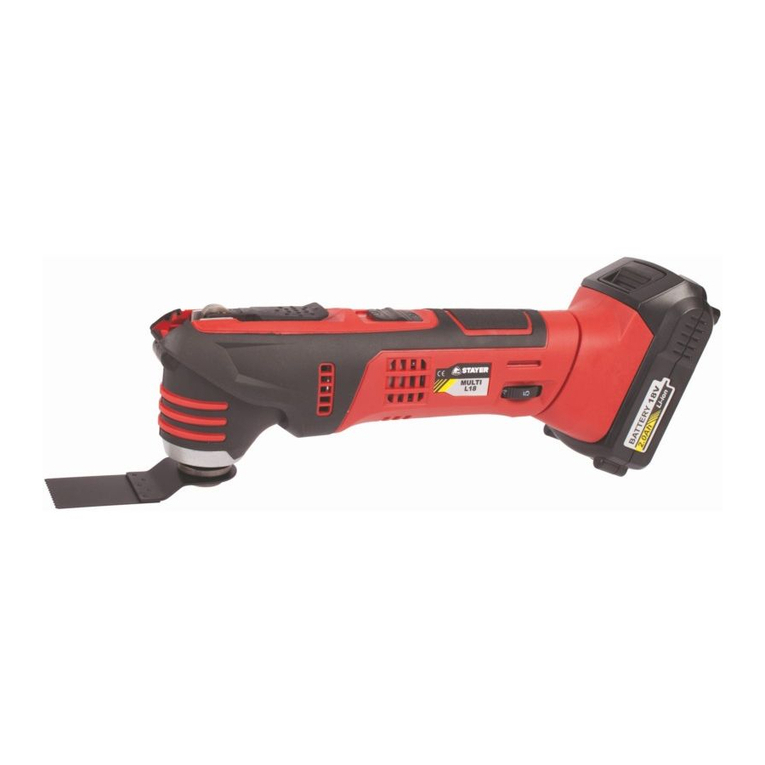
stayer
stayer VAC L 18 User manual
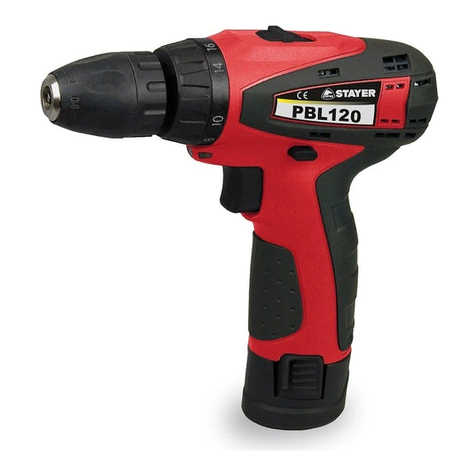
stayer
stayer BHL112K User manual
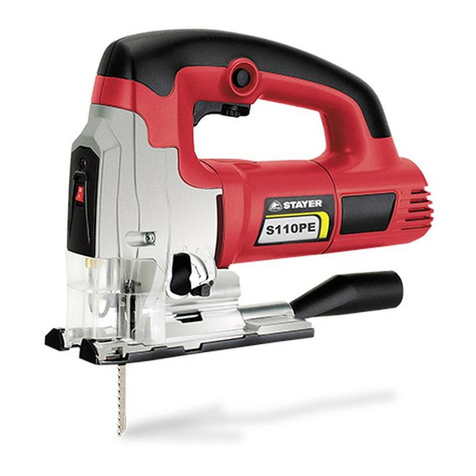
stayer
stayer S110PE User manual
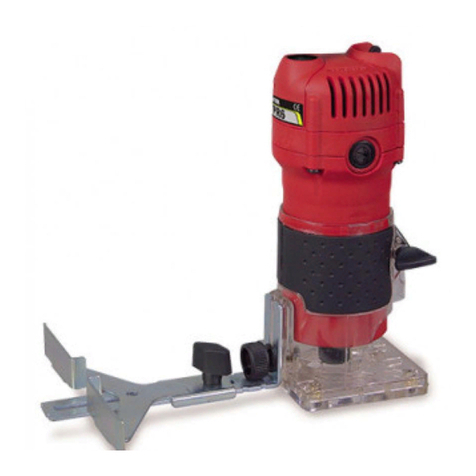
stayer
stayer PR6 User manual
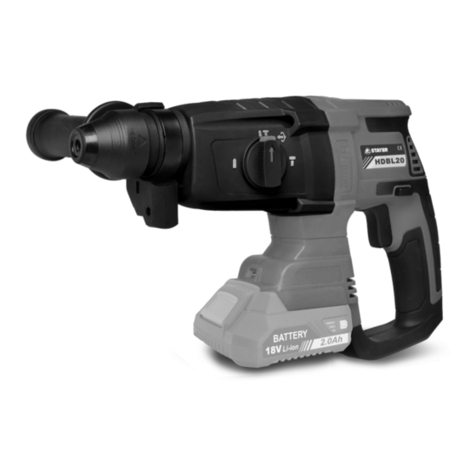
stayer
stayer HDB L20 User manual
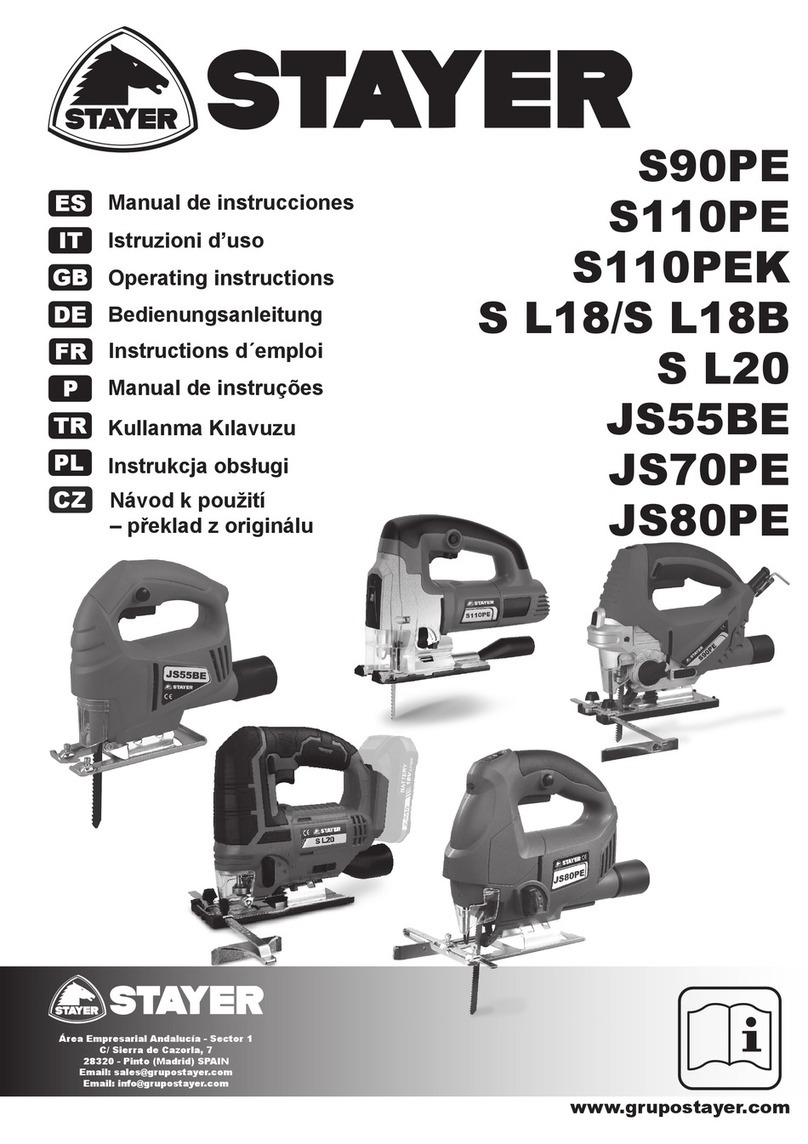
stayer
stayer S L18/S L18B User manual
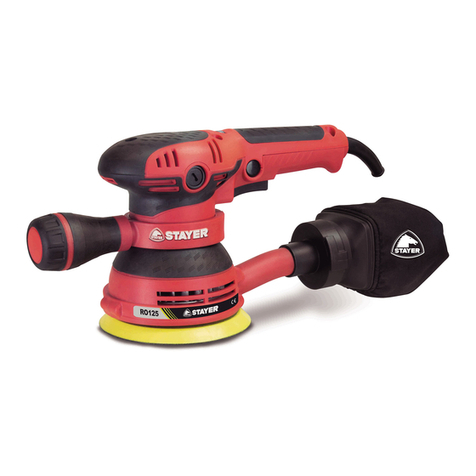
stayer
stayer RO125 User manual
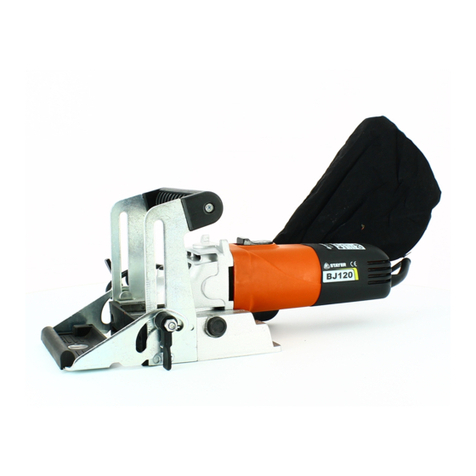
stayer
stayer BJ120 User manual
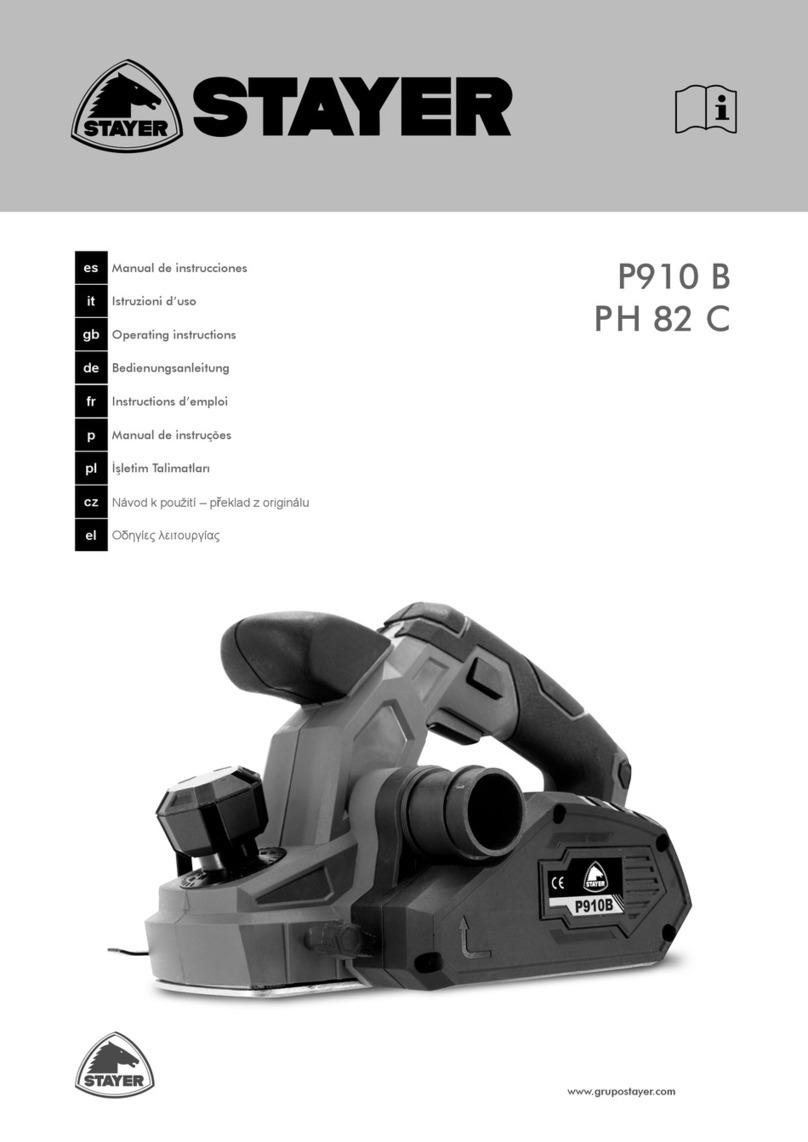
stayer
stayer P910 B User manual
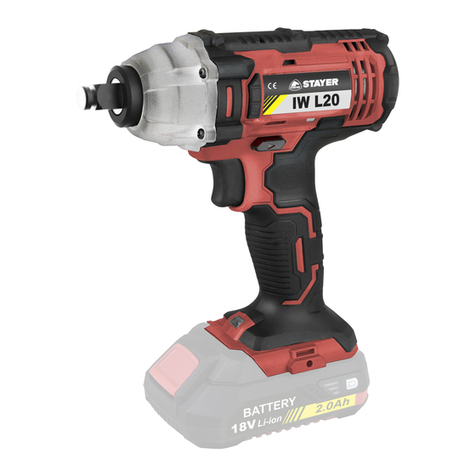
stayer
stayer ISL20 User manual
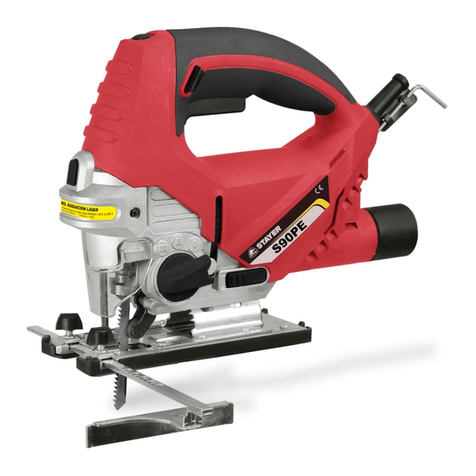
stayer
stayer S90PE User manual
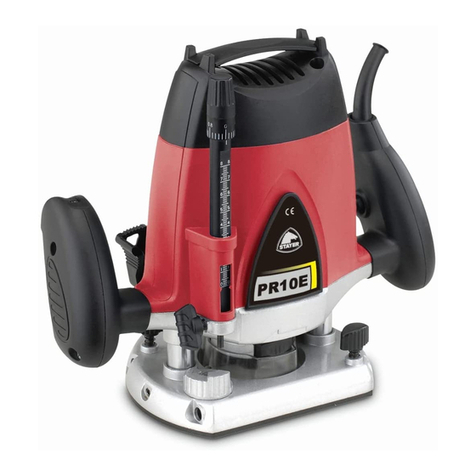
stayer
stayer PR10EK User manual

stayer
stayer SS210 User manual
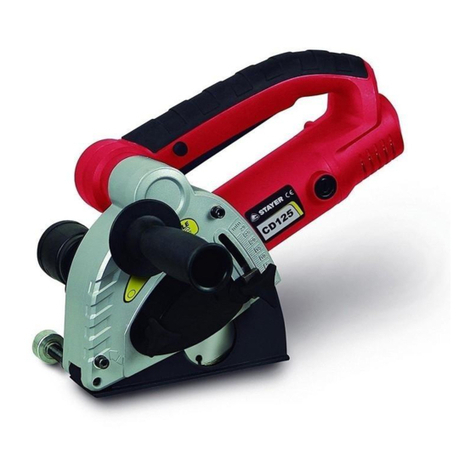
stayer
stayer CD125 User manual
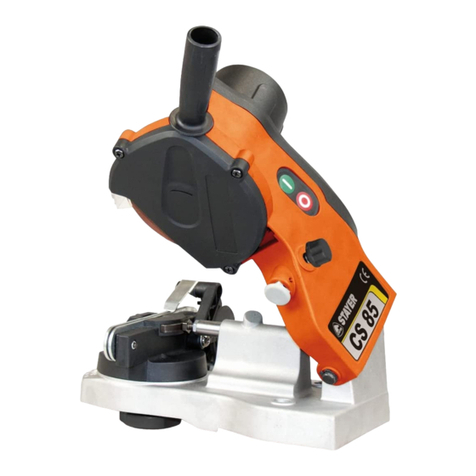
stayer
stayer CS85 User manual

stayer
stayer MULTI L20 User manual

stayer
stayer CD150K User manual
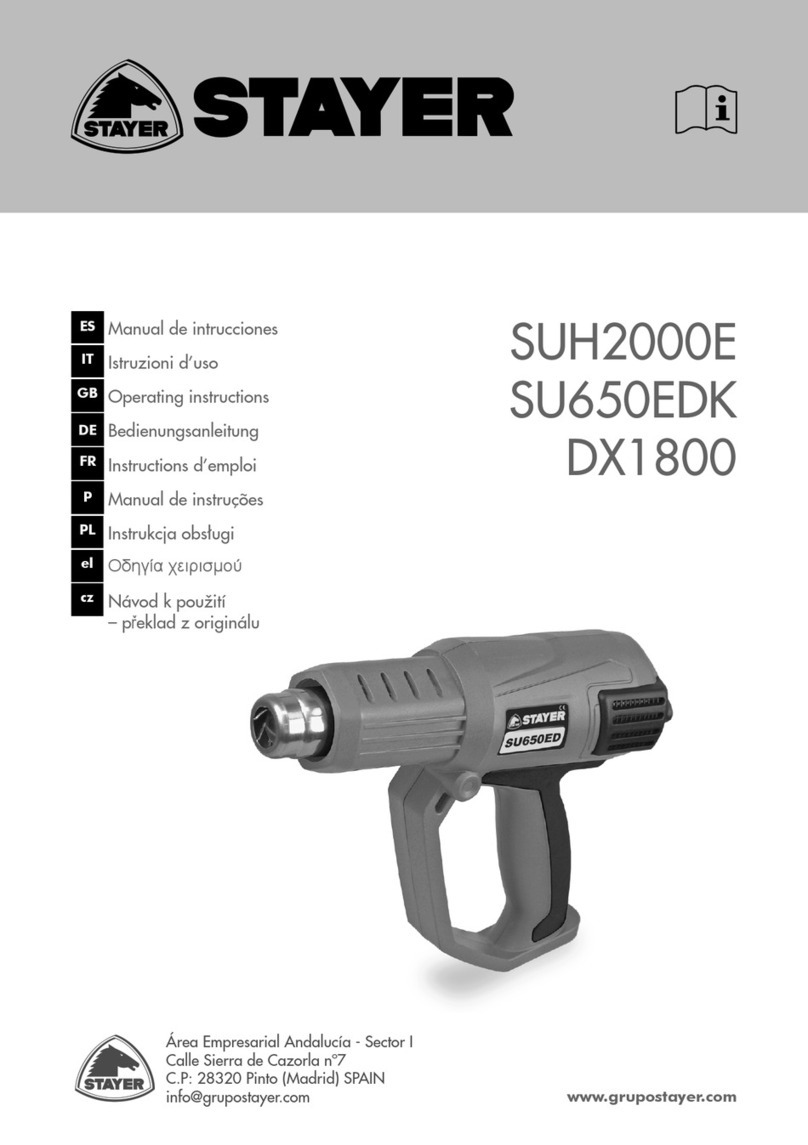
stayer
stayer SUH2000E User manual
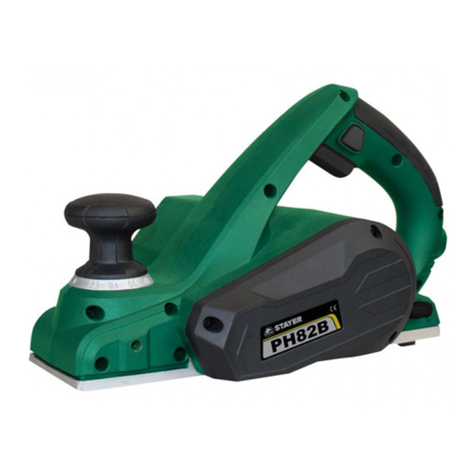
stayer
stayer PH82 User manual
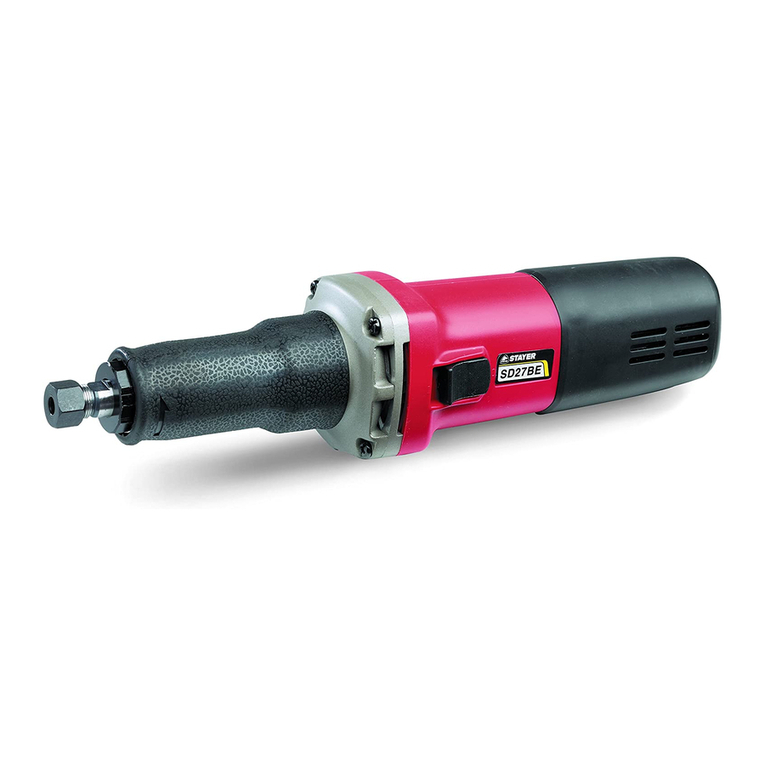
stayer
stayer SD27BE User manual
